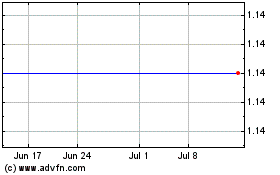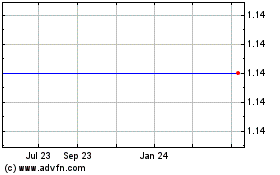Japan Disaster Shows Coverage Gaps, But Quake Still Costly For Insurers
March 11 2011 - 5:12PM
Dow Jones News
Despite the massive destruction caused by Friday's earthquake
and tsunami, the global insurance market won't bear the heaviest
burden when rebuilding begins because Japanese homeowners and
businesses have been reluctant to buy insurance to cover all of
their potential losses.
The cost will be borne more by the government and citizens of
Japan, making the recovery process more arduous than it would be on
other developed nations. Still, the massive scope of the disaster
will mean the portion covered by international insurers will be
well into the billions of dollars--and will likely be one of the
most expensive earthquakes in history.
Fewer than half of Japanese homes have earthquake protection,
and the policy limits are often well below the cost of rebuilding a
dwelling, experts on the Japanese insurance market said. Much of
the coverage is backed by a government-supported pool, called
Jisai, instead of being passed off to the global reinsurance
market, which protects insurers from large losses.
Still, some home insurance in Japan is sold through cooperatives
called kyosai, where agricultural groups, unions or other
organizations arrange the coverage for their members. Kyosai buy
backup protection from companies based outside Japan, unlike the
rest of the home-insurance market.
Businesses in Japan don't buy government-backed insurance,
relying instead on private insurance. But the coverage isn't
included in standard property policies, and the companies that buy
the added protection often don't purchase an amount that would
cover a total loss. Risk Management Solutions Inc., a
disaster-modeling company, said many small- to medium-size
businesses are "completely uninsured."
The earthquake that killed more than 6,000 people in Kobe in
1995 caused about $100 billion in economic damage. Only about $3
billion of it was insured, and much of the cost was borne by
domestic companies. The devastation--which struck a part of the
country that wasn't thought to be overly susceptible to
earthquakes--prompted more businesses to buy quake protection, said
James Few, president of the reinsurance operation at Aspen
Insurance Holdings Ltd. (AHL). But the increase in insurance buyers
has been less than expected. Both businesses and homeowners
perceived the coverage to be expensive, he said.
"It's not that this won't be a big loss" to the insurance
industry, said Few. "But the gap between economic loss and the
insured loss will still be far greater in Japan than you would
expect to see for a similar event in the U.S. or Europe."
RMS and its rivals haven't published estimates of insured losses
yet, but analysts who track insurance companies said insurance
claims could be $10 billion to $25 billion. One analyst said it
could be as high as $50 billion. Even at the low end of the range,
the losses would mark Friday's event as the second or third
most-expensive quake for the insurance industry in history. The
only quakes that rival it are the $15.3 billion earthquake in
Northridge, Calif., in 1995 and last month's temblor in
Christchurch, New Zealand, where costs are still being tallied.
Investors on Friday were busy trying to sort out which insurers
and reinsurers would be hardest hit, though the companies
themselves declined to comment or said it was too soon to say.
Flagstone Reinsurance Holdings SA (FSR) plunged 12% in afternoon
trading to $9.65. The company said in a filing with securities
regulators last week that it sold a "significant amount of
catastrophe" coverage in Japan, though it wasn't its largest
market. Lloyd's of London underwriter Chaucer Holdings Plc (CHU.LN)
fell 6.5% to 54 pence. Other decliners included the world's largest
reinsurers, Swiss Reinsurance Co. (RUKN.VX) and Munich Re; and
smaller firms, including Platinum Underwriters Holdings Ltd. (PTP),
Montpelier Re Holdings Ltd. (MRH) and TransAltantic Holdings Inc.
(TRH). All fell 4% or more.
Still, industry executives said international insurers and
reinsurers will be able to meet their obligations tied to the
quake. But what happens to the industry next is a difficult
question to answer. Insurers are already on the hook for
substantial claims tied to storms and flooding in Australia and the
Christchurch quake, and analysts said many reinsurance companies
will report first-quarter losses and may end up losing money for
all of 2011.
This year's spate of disasters comes after costly earthquakes in
Chile and New Zealand last year, and some insurers and reinsurers
are also paying out claims tied to last year's oil spill in the
Gulf of Mexico.
After all the catastrophes, the Japanese quake could be cause
for a worldwide increase in the cost of disaster coverage, which
would be felt by buyers of insurance around the world.
Reinsurers have been flush with capital and have been cutting
prices as they compete for clients. But payouts on catastrophe
claims will deplete some of their excess capital and force a
re-evaluation of the areas where disaster costs can, theoretically,
be even higher, such as in hurricane-prone parts of the U.S. and
earthquake-prone California.
In addition, RMS recently released a new hurricane model that
drastically increased its estimates for potential storm costs in
parts of the U.S.
"Everybody is already talking about the impact on the U.S.
marketplace," said Rod Fox, chief executive of reinsurance broker
TigerRisk. The Japan earthquake, "when you combine it with the
model changes, will stop the slide in U.S. pricing and could have
even stronger effects going forward depending on the size of the
loss.
"Fifteen billion will stop the decrease in prices," he said. "To
the extent Japan starts getting larger than that, the impact
becomes even more significant."
-By Erik Holm, Dow Jones Newswires; 212-416-2892;
erik.holm@dowjones.com
--Leslie Scism and Vladimir Guevarra contributed to this
article.
XL Fleet (NYSE:XL)
Historical Stock Chart
From Mar 2024 to Apr 2024

XL Fleet (NYSE:XL)
Historical Stock Chart
From Apr 2023 to Apr 2024
